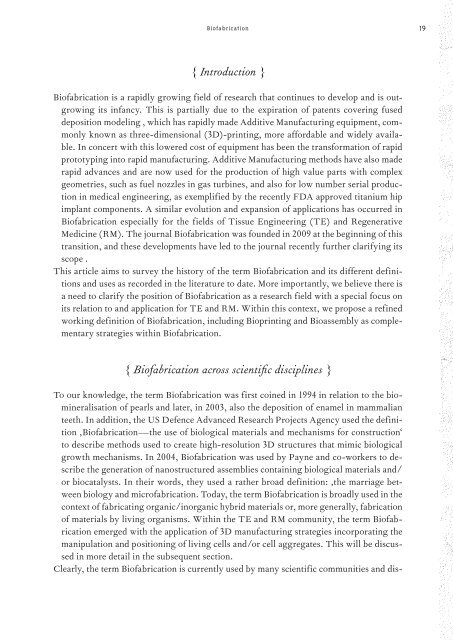Logbuch_17x24Druck_einzelseiten
You also want an ePaper? Increase the reach of your titles
YUMPU automatically turns print PDFs into web optimized ePapers that Google loves.
Biofabrication<br />
19<br />
{ Introduction }<br />
Biofabrication is a rapidly growing field of research that continues to develop and is outgrowing<br />
its infancy. This is partially due to the expiration of patents covering fused<br />
deposition modeling , which has rapidly made Additive Manufacturing equipment, commonly<br />
known as three-dimensional (3D)-printing, more affordable and widely available.<br />
In concert with this lowered cost of equipment has been the transformation of rapid<br />
prototyping into rapid manufacturing. Additive Manufacturing methods have also made<br />
rapid advances and are now used for the production of high value parts with complex<br />
geometries, such as fuel nozzles in gas turbines, and also for low number serial production<br />
in medical engineering, as exemplified by the recently FDA approved titanium hip<br />
implant components. A similar evolution and expansion of applications has occurred in<br />
Biofabrication especially for the fields of Tissue Engineering (TE) and Regenerative<br />
Medicine (RM). The journal Biofabrication was founded in 2009 at the beginning of this<br />
transition, and these developments have led to the journal recently further clarifying its<br />
scope .<br />
This article aims to survey the history of the term Biofabrication and its different definitions<br />
and uses as recorded in the literature to date. More importantly, we believe there is<br />
a need to clarify the position of Biofabrication as a research field with a special focus on<br />
its relation to and application for TE and RM. Within this context, we propose a refined<br />
working definition of Biofabrication, including Bioprinting and Bioassembly as complementary<br />
strategies within Biofabrication.<br />
{ Biofabrication across scientific disciplines }<br />
To our knowledge, the term Biofabrication was first coined in 1994 in relation to the biomineralisation<br />
of pearls and later, in 2003, also the deposition of enamel in mammalian<br />
teeth. In addition, the US Defence Advanced Research Projects Agency used the definition<br />
‚Biofabrication—the use of biological materials and mechanisms for construction‘<br />
to describe methods used to create high-resolution 3D structures that mimic biological<br />
growth mechanisms. In 2004, Biofabrication was used by Payne and co-workers to describe<br />
the generation of nanostructured assemblies containing biological materials and/<br />
or biocatalysts. In their words, they used a rather broad definition: ‚the marriage between<br />
biology and microfabrication. Today, the term Biofabrication is broadly used in the<br />
context of fabricating organic/inorganic hybrid materials or, more generally, fabrication<br />
of materials by living organisms. Within the TE and RM community, the term Biofabrication<br />
emerged with the application of 3D manufacturing strategies incorporating the<br />
manipulation and positioning of living cells and/or cell aggregates. This will be discussed<br />
in more detail in the subsequent section.<br />
Clearly, the term Biofabrication is currently used by many scientific communities and dis-


